Chick-fil-A marketing strategies have helped the brand to successfully carve a distinct identity for itself in the highly competitive fast-food industry. It was founded by Truett Cathy in 1967 and has become people’s favorite over the years and has grown to be one of the renowned fast-food restaurant chains across the globe.
This American fast-food restaurant chain specializes in chicken sandwiches and is headquartered in College Park, Georgia. It runs and operates about 2,987 restaurants across 48 states, including the District of Columbia and Puerto Rico. The brand is one of the largest fast food chains, which has a breakfast menu, lunch and dinner menu.
It provides catering services and is widely known for its commitment to exceptional quality, customer service, and strong values. The brand has built its reputation on serving high-quality food made from fresh ingredients and has been able to differentiate itself from other fast-food chains by focusing on chicken-based menu offerings.
In this article, we will discuss some of the marketing strategies that Chick-fil-A uses to stay ahead of the competition in the food industry as well as its marketing mix.
Read about: Tim Hortons Marketing Strategies
What is the marketing strategy of Chick-fil-A?
Chick-fil-A marketing strategy is built around the marketing mix framework of the 4Ps (Product, Price, Place, Promotion). The brand markets and promotes itself through TV commercials, radio broadcasts, billboards, social media marketing, word-of-mouth advertising, and targeted marketing campaigns. Other strategies include sponsoring charitable initiatives and sports, partaking in local events, in-store promotions, and the use of targeted online advertisement.
Chick fil A marketing strategies have played a crucial role in its success as a leading fast-food brand with a strong and loyal customer base. Despite having fewer locations compared to some of its competitors, the fast food chain has still been able to consistently achieve impressive growth and customer loyalty. By implementing various marketing strategies and delivering exceptional food and service, it continues to stand out in the competitive market.
See also: Lululemon Marketing Strategies and Marketing Mix
Chick Fil A Marketing Strategies
- STP marketing (Segmentation, Targeting, and Positioning)
- Traditional marketing and advertising
- Digital and social media marketing
- Exceptional customer experience
- Community involvement
- Use of targeted marketing campaigns
- Improving and introducing new products
- Sponsorships and endorsements
- In-Store promotions
- Targeted advertising via the Chick-fil-A One mobile app
Through its effective marketing strategies, Chick-fil-A has been very successful at reaching its target market. By focusing on key elements like product innovation, customer experience, brand consistency, and community involvement, the brand has successfully positioned itself and established a strong presence in the fast-food industry.
STP marketing (Segmentation, Targeting, and Positioning)
One major marketing strategy of Chick-fil-A is to segment its market, select its target segments, and position itself to meet its customers’ needs. This STP marketing framework helps the fast food chain to identify and understand its target market; position its brand in a competitive landscape, and develop effective marketing strategies.
Chick-fil-A’s STP marketing strategy has been key to its success as a leading fast-food brand. The brand has been able to build a strong brand and a loyal customer base by effectively segmenting the market, targeting specific customer groups, and positioning itself as a provider of high-quality chicken-based meals with a brand reputation that is identified with exceptional service and strong values.
Segmentation
When marketing and trying to reach an audience it is evident that not all customers have the same preferences and needs. Hence, as part of its marketing strategies, Chick-fil-A employs several segmentation variables to divide the market into distinct groups. This helps the brand to effectively serve its diverse customer base.
These segmentation variables may include demographic factors (e.g. age, income, and gender), behavioral factors (such as usage frequency and customer loyalty), and psychographic traits (such as lifestyle and values). Segmenting its target audience enables the brand to implement effective marketing approaches that will appeal to a specific target audience.
For instance, a marketing strategy of Chick-fil-A that is tailored toward a specific target audience like families is the brand offering kid-friendly menu options like its 5 Ct Nuggets Kid’s Meal, 2 Ct Chick-n-Strips® Kid’s Meal, and 5 Ct Grilled Nuggets Kid’s Meal and play areas in some of its restaurants.
It also provides promotional activities that appeal to parents such as the “Mom’s Valet” service that avoids parents standing in line with a group of children. This service makes parents’ lives a bit easier as they can order the family’s meals at the drive-thru while keeping everyone safely contained in the car, and then when they enter the restaurant, a table is already prepared for them with high chairs if needed.
Another example of this fast food brand tailoring toward a specific target audience is tweaking its menu options to resonate with specific lifestyles like healthy living. Chick-fil-A caters to health-conscious individuals by adding grilled chicken and salad options to its menu. It offers salad options like Cobb salad, Market salad, and Spicy Southwest salad which can be ordered with its nuggets, Chick-n-Strips, or filet.
Targeting
Once its target market is segmented, Chick-fil-A selects specific segments to focus its marketing strategies on. By targeting specific segments, the fast food brand can tailor its offerings and marketing messages to resonate better with the preferences and needs of its customers.
For instance, being a fast food provider, Chick-fil-A targets working professionals who don’t have the luxury of time to cook and prepare meals themselves. Hence, the fast food restaurant incorporates technologies and strategies that appeal to these busy professionals such as introducing mobile ordering options, and drive-thru facilities, as well as emphasizing its quick and convenient service in its marketing messages.
Similarly, the brand targets college students and as a result, opens its restaurants near campuses and offers late-night dining options.
Also, based on the quality of its foods and the prices the brand offers, it targets high-income earners as its potential customers. The brand places the prices of its products slightly higher than its competitors which targets the middle to upper-middle class.
Such people have the disposable income necessary to comfortably eat out on a regular basis at Chick-fil-A and are always willing to pay a premium because they feel the price is justified by the quality of the products.
Positioning
Positioning is another key marketing approach of Chick-fil-A. This is about showing its target audience how it wants to be perceived in the minds of customers, in order to differentiate it from competing brands like McDonald’s, Taco Bell, Subway, KFC, Burger King, Wendy’s, Chipotle Mexican Grill, etc.
In order to secure a position in the market that sets Chick-fil-A apart from the competition, the brand had to ensure its products stand out from what is already on the market. This is why the brand has successfully positioned itself as a provider of high-quality, fresh, and delicious chicken-based fast food.
This chicken-based fast food chain works hard to make its product stand out by emphasizing its menu that appeals to a variety of tastes and preferences and its commitment to clean, inviting restaurants, and exceptional customer service.
Chick-fil-A also positions itself as a brand with strong values that also focus on community development. Its commitment to closing on Sundays to allow employees to honor their religious beliefs and spend time with family gives customers a certain perception about the brand being dedicated to its principles.
Traditional marketing and advertising
One of the marketing strategies that Chick-fil-A uses is traditional marketing and advertising. This is also known as physical marketing and involves the use of offline media like billboards, mail advertisements, TV and radio advertisements, newspaper ads, and other print ads to reach its target audience and create awareness about its brand.
Chick-fil-A does the occasional print ad or coupon mailer, but the most common traditional advertising methods that it uses to market to its target audience are billboards and television ads.
Billboards
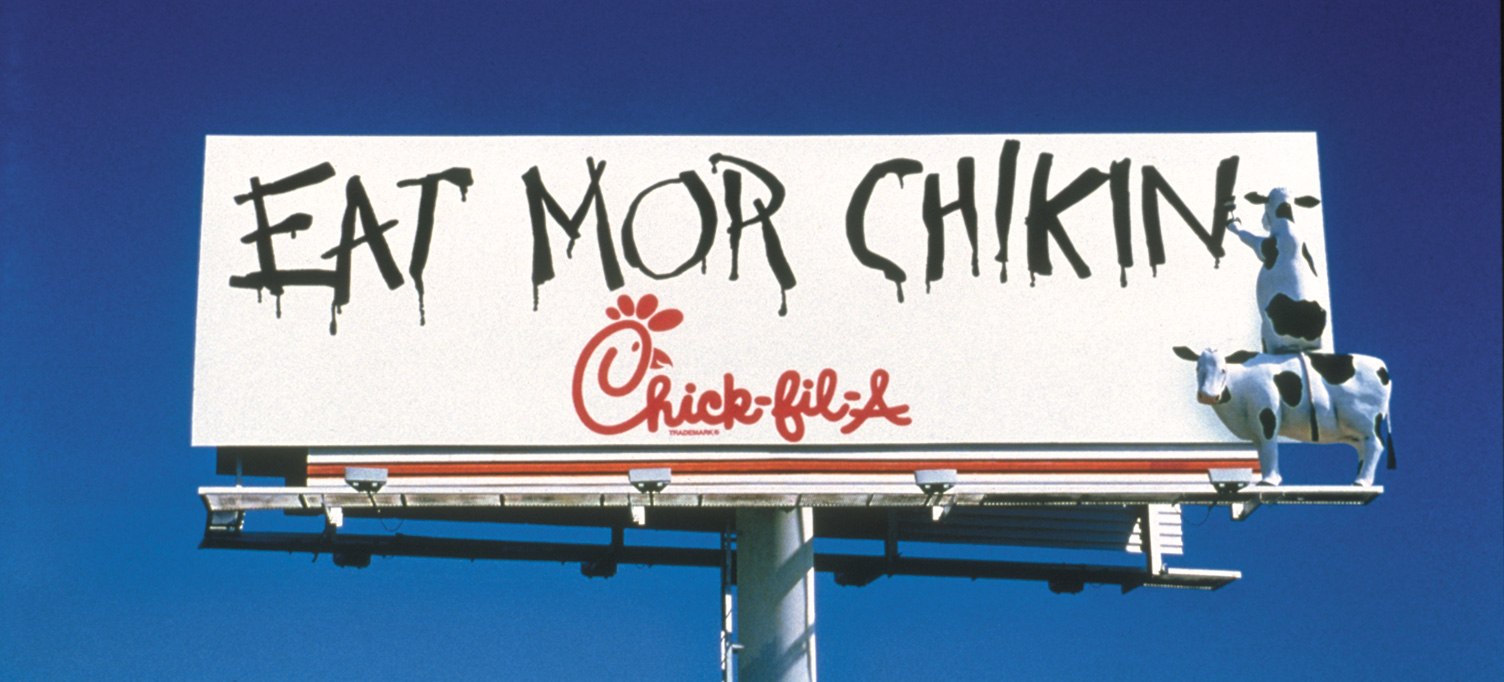
This fast food brand’s billboard advertisements are built on OOH advertising (Out Of Home ads). When driving along any major roadway in the USA, one will eventually come across a Chick-fil-A billboard as a friendly reminder that there is a Chick-fil-A restaurant nearby.
The brand cultivates brand awareness and brings the public information about its restaurant by putting up billboards with a catchy saying that is strong enough to stick in people’s brains long enough for them to remember the brand when ready for their next meal.
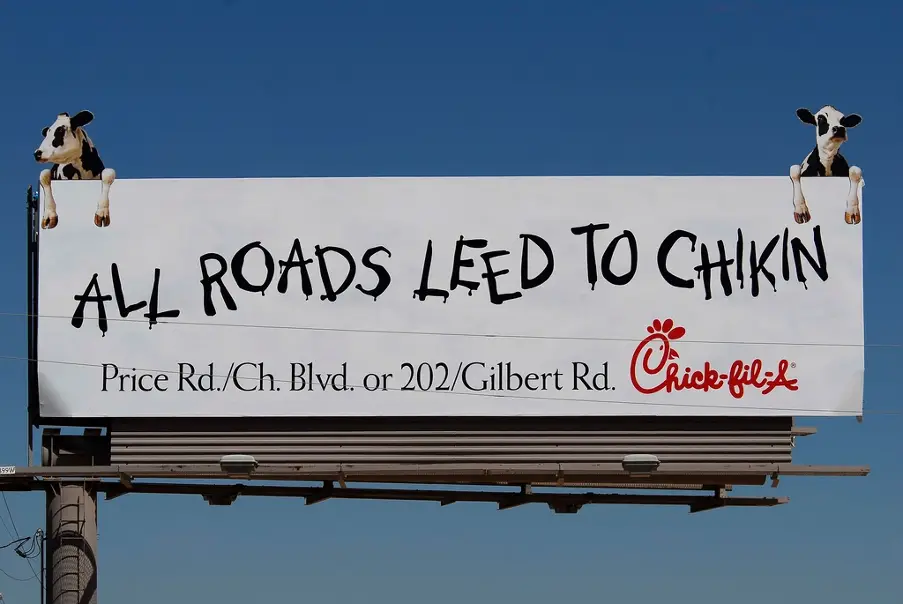
Chick-fil-A was able to launch many successful billboards through its cow campaign. The majority of its billboards use a popular billboard design that combines a humorous saying with Holstein cows.
With the launch of the cow campaign, cows became an integral part of Chick-fil-A; with a majority of its billboards playing off the idea of “dumb cows” who could not write well, hence, the misspelled words and sloppy paint. The entire cow campaign started with a single billboard with three simple words “Eat Mor Chikin” which became recognizable, and over the years the font, cows, and misspelled words became a hallmark of Chick-fil-A.
As a marketing strategy, Chick-fil-A uses its competitor’s primary product (cow) as a mascot for its billboard, encouraging its target audience to eat chicken in order to save cows. With every billboard that is conveniently placed on busy highways, water towers, and stadiums, the brand keeps finding creative ways to encourage humans to put down their burgers and eat chicken instead.
For instance, the phrase “Burgerz R 4 Losers I’M Just Sayin” on a billboard calls out some of Chick-fil-A competitors like McDonald’s and Burger King without having to call their names.

The billboard slogans indirectly discourage consumers from eating Chick-fil-A opposition’s primary product (beef) and in turn drive the sale of its chicken-based meals.
The brand also makes use of billboards to advertise new menu items. For instance, the picture below is an example of Chick-fil-A advertising its grilled chicken sandwich on a billboard.
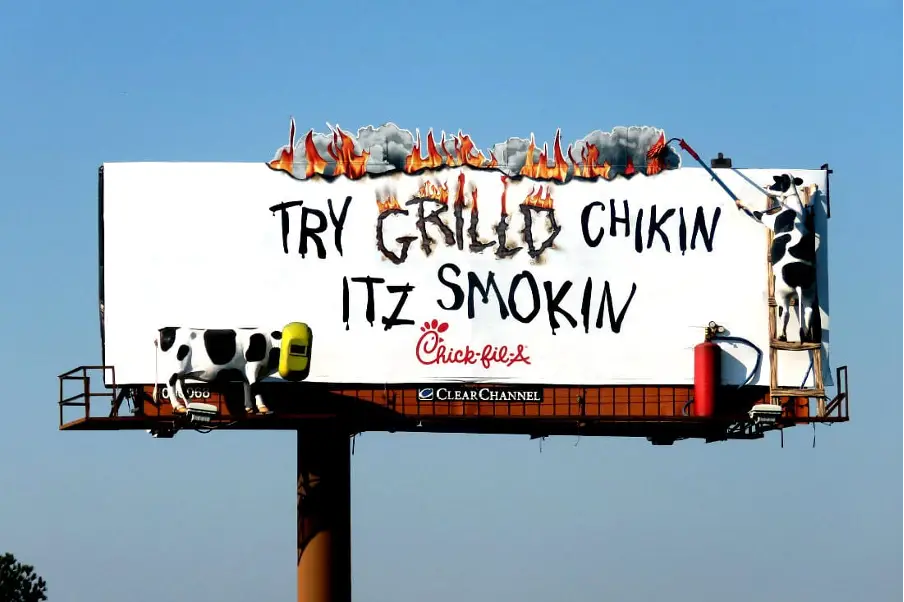
Television Ads
Chick-fil-A runs television ads as part of its marketing strategy, especially during the holidays, and televised sporting events. Such television ads reach a wider audience such as young adults, sports fans, families, moms, etc.
The brand airs TV commercials for new product launches such as the Chick-fil-A Chicken Biscuit Commercial, and the Chick-fil-A Honey Pepper Pimento Chicken Sandwich commercial.
Apart from making commercials to advertise new product launches, the brand also runs commercials that sell a feeling. The Little Things commercial, for instance, is known for its heart-warming content about kindness, joy, and exceptional customer service. This reinforces Chick-fil-A’s branding, positioning it in the minds of consumers as a restaurant chain that takes pride in its customer service.
This commercial features Team Members and customers telling the story about the little moments of joy that happened between them. The commercial does not directly market the brand’s product to the audience but sells a feeling and a perception of how Chick-fil-A is highly dedicated to serving its customers and local communities, which in turn drives sales.
Digital and social media marketing
Another prominent marketing strategy that Chick-fil-A uses is digital marketing. It uses the internet and other forms of digital communication to promote its brand and connect with potential customers. The brand has a strong social media presence, and as of 2019, it received the highest social ranking among all restaurants by Netbase.
On various social media platforms like Facebook, Instagram, Twitter, and YouTube, Chick-fil-A has been interacting with a wider audience, sharing content and informing customers about its product offerings. This promotional strategy has been effective in bringing about engagement and patronage from a lot of persons cutting across various demographics.
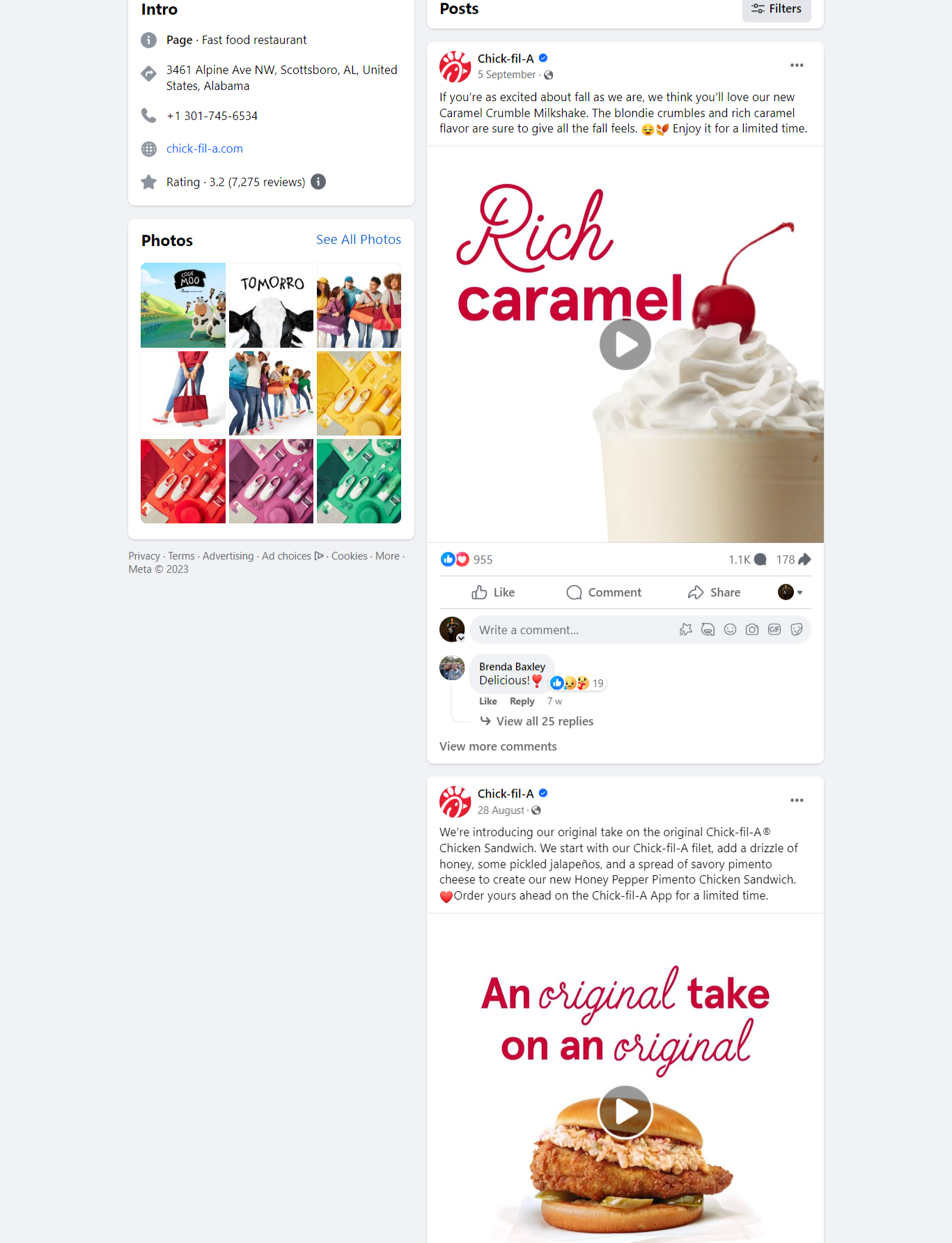
As of October 2023, Chick-fil-A has over 7.5 Million likes on its Facebook page. On its Facebook page, the brand provides links to local store pages and events, photos and videos about its products, and other information.
On Instagram, Chick-fil-A has about 1.9M followers as of October 2023. It makes a new post at least every month to advertise a new menu item, share affirmations to make customers feel better, and share other pieces of information.
YouTube
Chick-fil-A also shares videos on YouTube as part of its content marketing strategy. This brand has a YouTube Channel of over 74K subscribers with millions of views. In order to create brand awareness, it posts multiple videos on the channel that cover a variety of topics such as recipes, customer experiences, local store activities, dancing cows, TV commercials, etc.
Some of the videos on the channel are about Chick-fil-A’s products while most of the video focuses on the brand’s customers or serving the community.
Posting consumer-generated content like the CFA Couches series and value-based content like the animated Stories of Evergreen Hills on YouTube sells a feeling to viewers; it creates a perception in the minds of consumers that the brand has strong values and has its customers and community at heart.
This content marketing strategy sells the brand and positions the brand in the minds of consumers as a customer-oriented brand that is committed to providing exceptional customer service and not only high-quality, fresh, and delicious chicken-based fast food.
See also: Costco Positioning and Marketing Strategies
Exceptional customer experience
One of Chick-fil-A marketing strategies is customer experience marketing. This involves the brand improving how consumers encounter and interact with its products and services. This fast food brand ensures every touch point consumers have with it as a brand is exceptional, beginning from their first interaction up til when they become lifetime customers.
Chick-fil-A emphasizes providing an exceptional customer experience; it focuses on meeting customer expectations and having positive interactions, conversations, and engagements with them. The brand is known for its efficient service, friendly and attentive staff, as well as its clean and welcoming restaurants.
It puts many resources into training and paying its employees well enough to deliver outstanding customer service, which results in positive interactions that leave a lasting impression on customers. Chick-fil-A is so particular about quality products and services that it runs a unique business model that enables the brand to tightly control its high standards in locations.
It is one of the most selective chains in the industry and it accepts just 0.4% of people who apply to open Chick-fil-A locations. Operators have to pass a very extensive interview process and training regimen to become franchisees and the selected ones are usually restricted to only opening a single location, which is a rarity in the fast food industry where many franchisees have dozens of locations.
Such restriction and other specific standards of the brand helps to guarantee that locations across the US maintain the same level of quality and customer service which have led to sustained success and high customer satisfaction.
The brand employs a generous approach to customers that makes them feel cared for and also makes its restaurant design warm and inviting so that customers want to come back and spend time in the restaurant.
According to the American Customer Satisfaction Index’s (ACSI) annual restaurant report, 2022 was the ninth year in a row that Chick-fil-A has earned the top spot in the fast-food industry as the chain with the best customer satisfaction score. It earned an ACSI score of 85 out of a possible 100 points and has continued to set the standard with its exceptional customer service, polite employees, and cleanliness.
Exceptional customer experience and unfailing hospitality have therefore been a huge part of Chick-fil-A’s success. Quirks, such as, workers saying “my pleasure” instead of the common “you’re welcome”, little gestures like placing flowers on tables, and offering free food are all marketing strategies of Chick-fil-A that have helped it keep the top spot for best customer service.
Community involvement
Community involvement is an integral part of Chick fil A advertising strategy. The brand sponsors major sporting events like the Peach Bowl each year, participates actively in local events, supports youth development programs, and sponsors charitable initiatives.
This in turn enhances Chick fil A brand image and creates brand awareness. By engaging with the community and giving back, the fast food brand is able to strengthen its connection with its customers and foster goodwill.
Sponsoring charitable initiatives
One prominent Chick fil A advertising strategy is sponsoring charitable initiatives and engaging in philanthropic efforts. The brand is known for supporting various charitable organizations and initiatives, which focus on crucial areas like fighting hunger, education, and youth development.
As part of its charitable initiatives, the brand awarded about $22 million in True Inspiration Awards® grants for the year 2022, donated 18 million meals to Feeding America, and 132,000 students cultivated leadership skills through the Chick-fil-A Leader Academy. Such initiatives may not directly market the brand’s product but help to strengthen its brand image and foster a sense of goodwill among customers.
For instance, operators donating quality, surplus food that is unused to shelters, local soup kitchens, and other nonprofits to feed children, seniors, and others through the Chick-fil-A Shared Table® program sends a strong positive message to the audience. It shows that the brand is highly committed to its community and has strong principles and values. This is one factor that makes Chick-fil-A unique among its competitors.
Such publicity moves are effective marketing strategy because it highlights the brand’s strong values to its target audience which in turn wins the hearts of many customers and makes them emotionally attached to the brand. Thus, resulting in increased patronage and a larger loyal customer base.
Participating in local community events
It is peculiar to the Chick-fil-A brand to be involved in community-specific customs and events as an advertising strategy. Each Chick-fil-A location works hard to connect to the local community by engaging in local customs and events.
The brand participates actively in community customs and events, decorates with local/regional specific marketing pieces, and provides in-store promotions and activities. This in turn goes a long way to create awareness about the brand in the immediate community.
For example, as an active member of a community, Chick-fil-A celebrates the Fiesta ten-day party in San Antonio that dates back to 1891 and even has its own collectible Fiesta medal each year. Being part of such local customs sells a feeling of belonging that resonates with many customers.
The locally-themed decorations used and location-specific activities that Chick-fil-A partakes in, provide good potential for word-of-mouth advertising. This is because consumers tend to discuss the items or activities that are unique to the brand within their peer group, thus creating brand awareness.
The brand also hosts its own local events as a form of advertising like the Cow Appreciation Day, an annual event that encourages fans to come to the restaurant dressed as a Cow. Some locations even host Stuffed Animal Sleepovers, School Spirit Nights, or Kid’s Nights.
In such events, there are games for kids, contests, and free food which leaves a long-lasting memory in the minds of consumers, thus encouraging subsequent patronage. Such local events help build a sense of community with families and help to encourage brand preference among families and youth.
The use of targeted marketing campaigns
One of the marketing strategies of Chick-fil-A is the use of targeted marketing campaigns. The brand strategically crafts an organized course of action and activities that resonate with its target audience in order to promote and sell its products.
In its targeted advertising campaigns, it often highlights its commitment to quality, customer service, and community involvement. The brand reinforces its brand messaging through its various marketing campaigns and leverages various channels, including social media, television, and outdoor advertising, to reach a wide range of customers.
Popular marketing campaigns of Chick-fil-A
- The Little Things campaign
- Together Time ad campaign
The Little Things campaign
In recent times, due to increased competition and the fact that most consumers desire personal connections with brands, leaving an impression has become more difficult for many fast-food brands. This has forced many of them to enhance their marketing efforts up a notch; one of the reasons why Chick-fil-A came up with the “It’s the Little Things” campaign.
This marketing campaign highlights brand intimacy, which is an intangible quality that the brand brings to its customer interactions. The “Little Things” campaign highlights the little things that Chick-fil-A employees do to make their customers’ lives a little better. It tells the story of little moments of joy that happened between the brand’s team members and customers.
The “Little Things” campaign rolled out nationally and has continued to this day with many local stores creating their own version of the campaign, including flower giveaways on the street.
There have been memorable stories shared through this campaign such as the story of an employee running down the block to catch up with customers who forgot their food and the story of an employee who held onto a customer’s forgotten change until he returned to the restaurant a month later. Another example is the story of an employee who translated the company’s app for a customer who spoke only Spanish and many more.
As seen, in some of the stories shared, there is a special heartwarming moment between Chick-fil-A team members and customers. In this campaign, looking at the surface, it looks like the brand is not directly trying to sell us anything because its product is being featured as a subtle piece of the story in the background.
Nevertheless, if you look deeper, you will understand that the essence of this campaign is to sell us a feeling and perception. Sharing such stories celebrates and highlights the brand’s dedication to serving its customers and local communities. It sells the narrative that while the fast food chain is well-known for its chicken sandwiches and waffle fries, it also takes pride in its customer service.
This is a very effective marketing strategy because, through the #thelittlethings campaign, the brand is able to send a strong message to its target audience. Hence, Chick-fil-A is likely to appeal to every consumer who desires and loves an exceptional customer experience.
Together Time ad campaign
The Together Time ad campaign is one of the popular marketing campaigns that Chick-fil-A has used. This campaign was likely one of the reasons for the fast food finishing strong during the fourth quarter of 2019. The brand’s year-over-year foot traffic shares for the quarter grew by 18% in 2019.
Chick-fil-A commissioned a Bantam Group Survey in 2019 and over 90% of respondents agreed that the best holidays equaled time spent with their loved ones, over food and gifts. Hence, the brand created the “Together Time” ad campaign in response to this survey.
The “Together Time” campaign was fronted by a two-minute animated story that introduced a magical world called the Time Shop where the animated character, Sam, learns about “lost time,” “time that flies” and “together time”.
During this campaign, customers create a custom Time Card for anyone they like, especially someone they wish to give a little together time, and Chick-fil-A prints and ships the cards to the recipients for free.
The benefit that Chick-fil-A gets from this campaign is the positive brand association and lots of email addresses for possible inbound email marketing. This marketing approach is unique because by meeting a need, solving a problem, and fulfilling a desire, people feel good about the brand and are drawn to it. This in turn results in patronage and an extended customer base.
Aside from the “Together Time” invitation created to send to a loved one, Chick-fil-A went as far as creating a 130,000-square-foot replica of The Time Shop in New York City’s SoHo neighborhood. As a marketing approach, the brand made it free for families to read books, eat snacks, build snowmen, and share some quality together time in the Time Shop.
Improving and introducing new products
Another Chick fil A marketing strategy is the continuous innovation of its menu to meet changing marketing trends and customer preferences. Introducing new menu items, such as breakfast options, spicy chicken variants, and salads, enables the brand to stay relevant and attract new customers.
For instance, the brand got rid of cole slaw in 2016, which had been on its menu for 49 years, and replaced it with a kale and broccolini salad. Recently, it tested new menu items, including a smokehouse-barbecue bacon sandwich and a side of a baked potato at select restaurants, and launched frosted lemonade nationwide.
Introducing unique offerings markets the brand as satisfied customers do word-of-mouth advertisements to their family and friends, making Chick-fil-A stand out among the competition. This strategy also helps to retain loyal customers and encourages them to explore different offerings.
In-Store promotions
Another prominent Chick fil A marketing strategy is in-store promotions. This marketing strategy involves bringing people into the store to purchase specific items that are offered by the store itself.
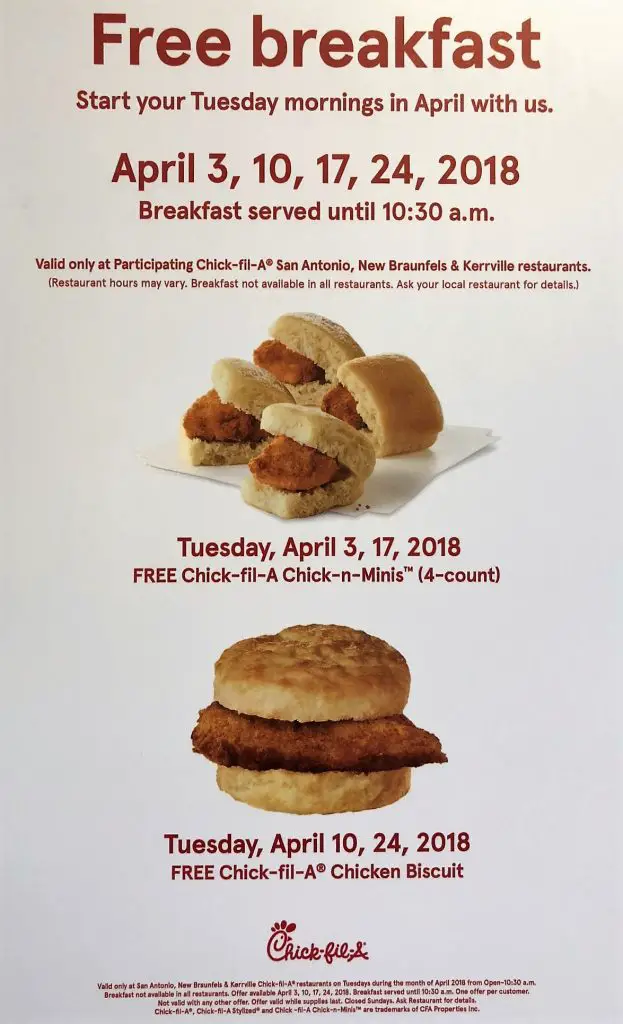
Many Chick-fil-A restaurants offer free breakfast items and other offers that are only peculiar to the store. They promote certain products to their local customers that are not advertised anywhere other than in-store or on the store’s Facebook page.
Targeted advertising via the Chick-fil-A One mobile app
The Chick-fil-A One mobile app connects consumers on the go with the brand, enhances customer experience, and drives engagement. This is another way that the fast food brand stays engaged with its customers and informs them about new menu items and other hot deals.
This digital innovation provides shopping convenience and a loyalty program for customers. Through the mobile app, customers can customize their meals, conveniently place orders, and earn rewards. The customer loyalty program on the app offers free menu items after a certain volume of food purchases which results in repeat purchases.
Chick-fil-A takes advantage of the engagement on the app and runs targeted advertisements by providing personalized recommendations and exclusive offers to customers via the app.
Hence, on the Chick-fil-A One mobile app customers are provided with a customized experience, interactive menu, store location, and information about local operators. This keeps customers engaged and encourages repeat visits and purchases.
Brand association
Creating positive brand associations has been one of Chick fil A marketing strategies. Brand association is a negative or positive personal connection that a customer forms between a brand and an experience, personality, emotion, attribute, or activity, which are strongly influential on purchase decisions.
Chick fil A’s strong values and corporate culture have helped in its success and positive brand association. Many of the brand’s values are influenced by the Christian religious beliefs of Truett Cathy, the founder, who was a devout Southern Baptist.
The 2022 American Customer Satisfaction Index confirms that this fast-food brand has remained the country’s favorite fast-food chain for eight consecutive years. The brand is known for its strong commitment to operating on Christian principles, such as closing its stores on Sundays, Thanksgiving, and Christmas Day to allow employees to honor their religious beliefs and spend time with family. This is one factor that makes Chick-fil-A unique among its competitors.
Such a strong emphasis on core values impresses a lot of customers and contributes to the brand’s positive image. For instance, during the Western Christian liturgical season of Lent, the fast food brand promotes fish sandwiches, due to the Christian tradition of abstinence from meat during Lent. Such thoughtful acts from the brand won the hearts of many Christians who interacted with the brand during this time and strong associations are built over time.
Positive brand association has been one of the most effective marketing strategies of Chick-fil-A because it leads to an increase in sales and a higher standing in consumers’ minds.
Check out: Tim Hortons Target Market and Customers
Chick-fil-A marketing mix
In order to succeed in business, every brand needs an excellent, well-coordinated marketing approach. To generate the kind of sales that results in a remarkable bottom line, the brand will need a good marketing strategy that takes into account the four main components of the marketing mix, product, price, place, and promotion known as the 4 Ps.
This takes into account how much a brand will consider charging for the product or service it is selling, as well as when and where the product will be sold. Hence, marketing mix refers to the combination of elements that a brand uses to promote its products or services.
Chick-fil-A’s effective marketing mix has been a key factor in the brand achieving remarkable success in the fast-food industry. The brand makes use of the 4Ps as an integral part of its marketing strategy and the careful balance of these four components has been instrumental in its growth and differentiation.
Let’s look at the details of Chick-fil-A marketing mix, and how each element contributes to the brand’s success.
Product
The product element of Chick fil A marketing mix focuses on its food offerings. The brand offers breakfast, lunch, and dinner as a part of its marketing mix product portfolio. As part of its marketing strategies, Chick-fil-A’s menu features a variety of chicken-based items and caters to various dietary preferences by offering grilled chicken options and vegetarian choices.
For breakfast, it offers varieties of sausage, bagels, eggs, nutritional biscuits, etc, and has different kinds of sauces and dressings. It also offers beverages like iced tea, juices, soft drinks, coffee, and milkshakes. The brand is widely known for its chicken-based menu items, such as its iconic Chick-fil-A Sandwich, chicken nuggets, salads, and wraps.
Chick-fil-A places a strong emphasis on the quality of its products and therefore ensures that its foods are made from fresh ingredients and prepared with care.
The brand takes pride in its chicken, which is sourced from reputable suppliers. In order to ensure quality, it sources 100% real, whole, boneless breast of chicken that has never been ground or separated and contains no fillers or added steroids or hormones, It also uses chickens that are raised in barns (not cages) in farms, with no Antibiotics and in accordance with its Animal Wellbeing Standards.
Chick-fil-A prepares its chicken using a unique cooking technique that ensures a tender and flavorful experience. Also, the fruits, veggies, and ingredients used to prepare the food it serves at its restaurants are grown on farms spanning the United States and freshly delivered to the restaurants up to six days a week.
Offering products that cater to various dietary preferences is a key marketable factor that Chick-fil-A puts into consideration. The brand has a separate section for kids’ meals, offering varieties of nuggets and other appealing items like Chick-n-Strips. The brand also offers salads in different forms for health-conscious people.
Price
One of Chick-fil-A marketing strategies is its pricing strategy. As the fast food chain implements marketing strategies that position it as a higher-end fast-food option, it also ensures that its prices remain competitive within the industry.
The brand uses a pricing strategy that strikes a balance between affordability and the perception of value. It uses a value-based pricing strategy in marketing wherein the prices of its products are slightly higher than its competitors, which is usually justified by the quality of the products it offers.
Customers perceive Chick-fil-A’s quality food and exceptional service to be worth the value and are usually willing to pay a slightly higher price for it. This value-based pricing strategy aligns with the brand’s strategy to target selective higher-income groups that can pay a certain amount for its offerings. Thus, enabling the fast food chain to make an annual revenue of more than 10 Billion USD every year.
Place
The place element in Chick-fil-A marketing mix involves the strategic locations where customers can access the brand’s products. As a marketing approach, this fast-food chain strategically chooses its restaurant locations.
In order to ensure brand visibility and accessibility, it usually targets high-traffic areas such as college campuses, shopping centers, and busy intersections. This allows the brand to maximize its visibility and convenience for customers. Hence, making its products easily accessible.
Chick-fil-A has a wide geographic presence with its outlets. It has managed to position itself as a premium quality fast-food brand in the USA, Canada, and other countries across the globe.
The brand tends to flourish in Christian-based states because it claims to have a corporative purpose to “glorify God” and in accordance with its Christian principles, its restaurants close on Sundays and other Christian holidays. This is a strategic move because it brings followers that eventually turn into customers.
Promotion
The Promotion element of Chick fil A marketing mix encompasses the various marketing activities that it utilizes to communicate and promote its brand and products. The brand utilizes a mix of traditional and digital marketing channels, such as outdoor billboards, influencer partnerships, television commercials, print advertisements, social media campaigns, content marketing, etc.
Chick-fil-A usually employs creative and engaging advertising content to resonate with its target audience and drive brand awareness; and uses promotional campaigns tied to specific events or holidays, such as its popular Cow Appreciation Day, where customers dress up as cows to receive free food.
Word-of-mouth marketing is also one of Chick-fil-A’s marketing strategies wherein the brand ensures customers have an exceptional experience and encourages them to share their positive experiences and recommendations with their family and friends.
Check out: Lululemon Target Market and Customer Base
Conclusion
Chick-fil-A marketing strategies and marketing mix is carefully crafted to deliver a unique brand image and position the brand positively in the minds of customers. The brand uses various mediums to advertise its products and promote its brand; using pretty much everything to increase its reach and encourage people to visit any nearest Chick-fil-A restaurant for an exceptional experience.
By considering and focusing on the 4P’s: product (high-quality products), price (competitive pricing), place (strategic restaurant locations), and promotion (innovative promotional campaigns), Chick-fil-A has been able to market itself effectively and establish a strong brand presence.
Focusing on the 4Ps consistently has enabled Chick-fil-A to differentiate itself in the fast-food industry, and offer a compelling combination of exceptional food, service, and value that keeps customers coming back for more.
Obotu has 2+years of professional experience in the business and finance sector. Her expertise lies in marketing, economics, finance, biology, and literature. She enjoys writing in these fields to educate and share her wealth of knowledge and experience.

